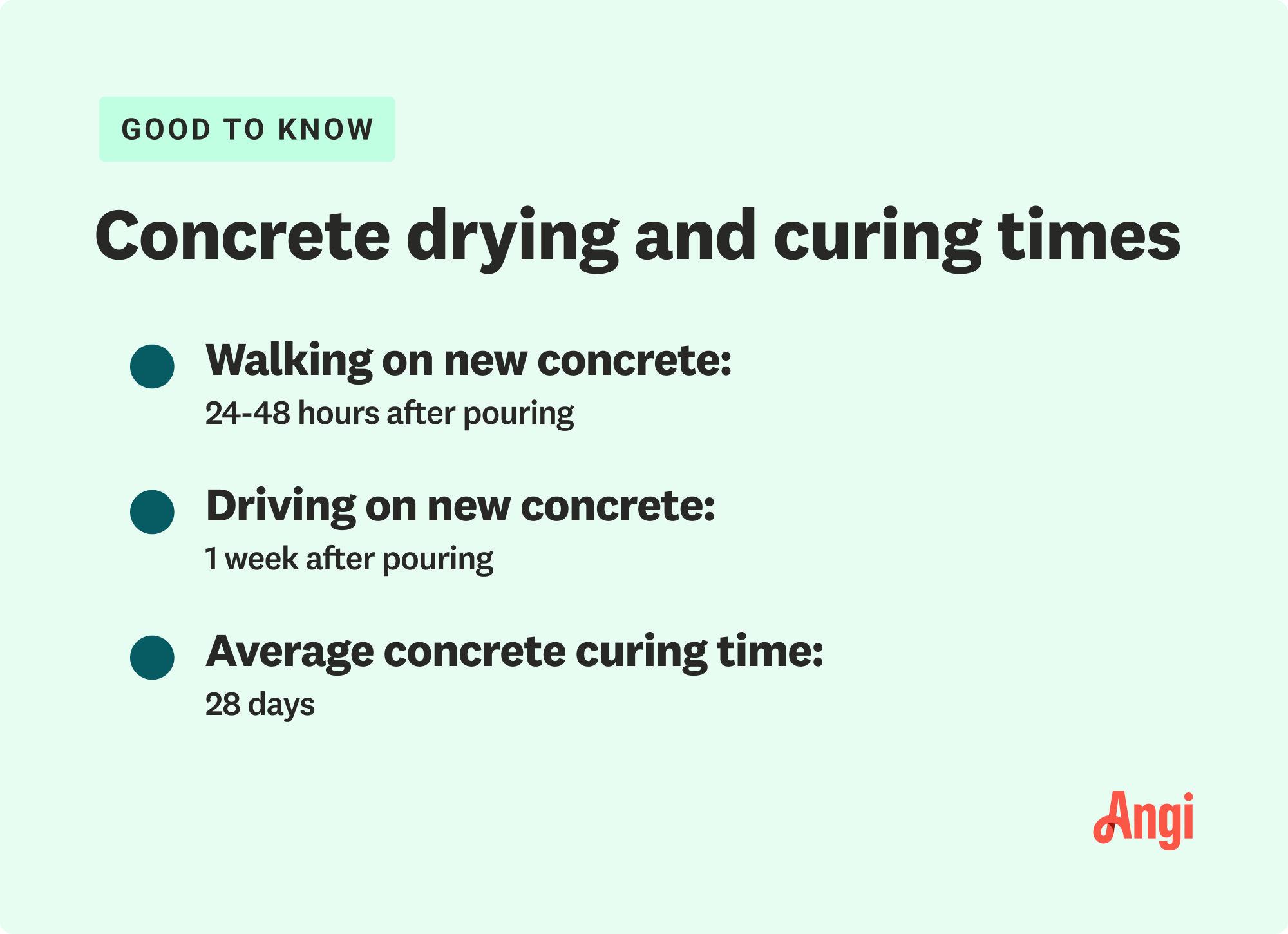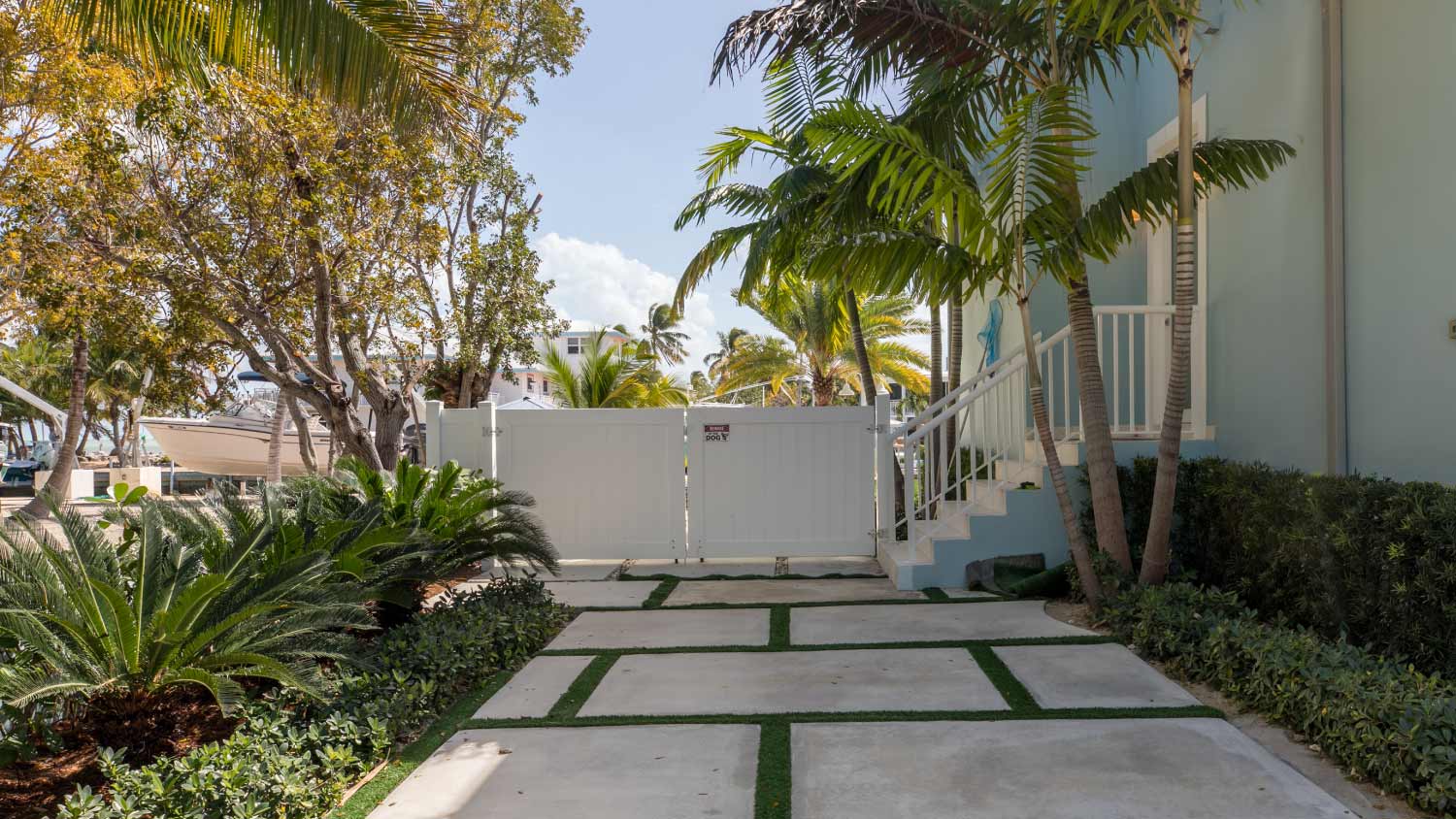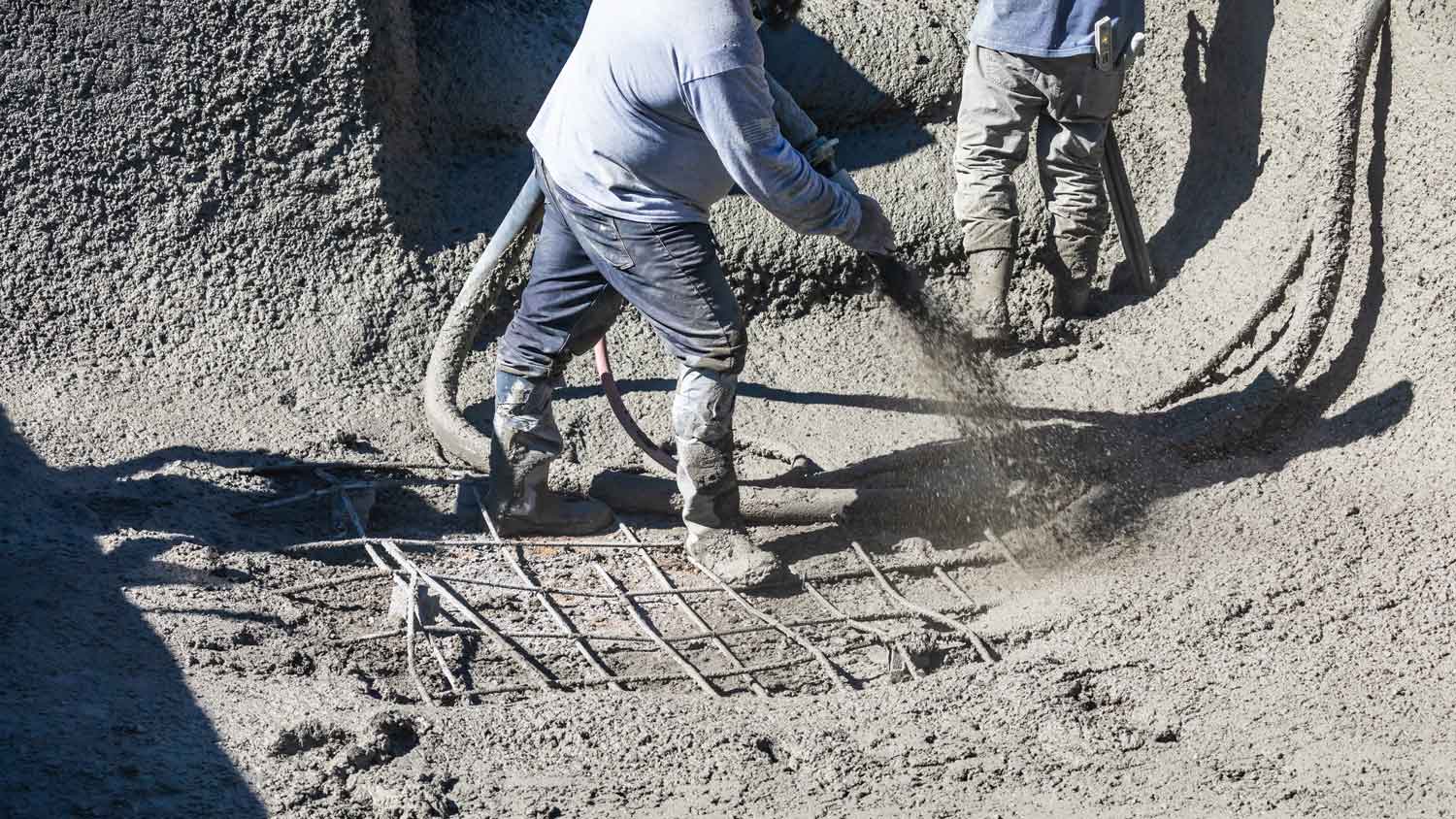
Concrete is a durable material but needs maintenance every few years. Use this concrete resurfacing cost guide to get an idea of ongoing maintenance costs.
Ensure proper drying time to have a concrete project that’s sublime


Concrete takes about 24–48 hours to dry before you can walk on it.
It will take up to one week before you can drive on new concrete.
Curing concrete takes longer than drying, about 28 days.
Whether you’re making a walkway for your garden or installing a new driveway, concrete is probably involved. But how long does concrete take to dry? Before you take another step, you’ll want to know everything about drying and curing times to ensure you don’t walk or drive on it before it’s ready.
Curing refers to giving concrete the time it needs to reach its full strength. Let’s explore in more detail the difference between concrete drying and curing below:
Drying: This first step refers to allowing the concrete to reach a moisture level that will support the material’s intended use.
Curing: This next step gives the crystals within the concrete mixture time to grow around the pieces of sand, stone, and/or gravel within the mixture to increase strength and durability. This process makes the concrete stronger and more water-tight, making it an ideal material for a driveway or a garden bed edge around moisture-loving veggies.
How long does it take concrete to dry? It takes 24 to 48 hours for concrete to dry enough to walk on and up to one week until you can drive on it, but it can take up to 28 days to cure.
Drying allows the concrete to reach a strength that can support some weight, so you don’t have to wait weeks before you can walk or drive on your driveway. But, the extra time for curing is what helps the concrete reach its full strength.

It takes cement 24 to 48 hours to dry enough to walk on it, up to one week to drive on it, and up to 28 days to fully cure. Cement and concrete take the same amount of time to dry. Cement is an ingredient of concrete. And concrete is made up of aggregate, like sand and crushed stones, as well as a paste made from cement and water. Without cement, there is no concrete.
Concrete takes 28 days to fully cure. Concrete cure time allows the material to become as strong as possible. While you may be able to open up the freshly cemented area to light foot traffic after a day or two, let the concrete cure for 28 days before you allow any heavy machinery or other large objects on the surface.
You can use several methods to cure concrete based on your climate, the specific concrete mix, and the size of the area. The right curing method is necessary to ensure the concrete is strong, durable, and resists cracking. No matter the method, curing concrete involves monitoring the temperature and moisture levels.
Here are some common methods for curing concrete:
Sprinkling with water
Spraying and fogging
Concrete formwork curing
Shading
Wet covering
Ponding and immersion
Steam curing
Membrane curing
Sheet curing
Hot mixing
Electrical curing
Infrared curing
Covering with sand, sawdust, or soil
Natural curing
Work with your concrete pro to determine the proper curing method, or read the instructions on your concrete mix if doing a DIY project.

You can’t wait to host a dinner party on your new stamped concrete patio, but you may wonder how long concrete takes to dry before you can add furniture. As it turns out, the weather in your area and even the concrete mixture you choose can impact how long it takes for the concrete to dry.
Concrete needs moisture—but if you add too much water, it can affect dry time and the quality of your concrete slump. The wetter your mixture, the longer it’ll take to fully dry. While it may seem like a good idea to add less water to the concrete mixture or pour concrete on a hot, dry day to speed up the drying process, these tactics can cause the concrete to have a more porous, weaker structure with an easily eroded surface.
That means you’ll spend a lot more time sweeping dusty concrete walkways and patios since the surface becomes sensitive without enough hydration during the drying process. Get a quote from a concrete patio pro if you need help with this project.
The ideal outdoor temperature for concrete to dry and cure properly is about 51 degrees Fahrenheit to 80 degrees Fahrenheit. If it gets too cold, the hydration process slows down too much. When the temperature is too high, the hydration process accelerates and can cause cracking in the concrete. Even if it doesn’t crack, it will dry too quickly and won’t develop its full strength.
It can be difficult to find a stretch of time with appropriate temperatures for pouring and drying concrete. Avoid pouring when it is too cold, and try some of these tips to keep the cement mixture cool enough while pouring on hot days:
Keep concrete mix bags in shaded or air-conditioned areas until it’s time to use them.
Mix the concrete with cool water.
Schedule the pouring for early in the day.
Wet the area before pouring the concrete, so the ground will pull this water rather than water from the concrete mixture.
Hire a concrete contractor to get the job done quicker.
Concrete mix design involves finding the right combination of concrete ingredients—like sand, crushed stone, gravel, cement, water, and any additional chemicals—to achieve the strength and durability necessary for your home improvement project.
While there are various types of concrete mixes, a quick-dry mix will be formulated for a faster dry time, but it might not hold up as well as a standard or high-performance concrete mix. This type of mix will take longer to dry but will be stronger and longer lasting.
The specific type of your concrete mixture impacts cure time. There are fast-setting concrete mixes and those that are more regular, traditional concrete formulas. Fast-curing concretes and add-ins can prompt faster curing but may impact long-term strength. Look at the label on your concrete to understand dry time, whether it’s reinforced concrete, high-density concrete, stamped concrete, ready mix, or decorative concrete.
If you don’t wait for concrete to dry, the concrete’s structural integrity, durability, and appearance suffer. It’s critical to watch the moisture and temperature in the initial days after pouring concrete to ensure proper bonding and drying. If you walk or drive on the concrete too soon, it can lead to cracking and reduced strength. It can also leave an imprint, forever altering the look of your concrete.
Yes, you can speed up concrete dry time by using warm water to mix the concrete, using a quick-drying mix, or pouring the concrete on a really hot day. But a slow, methodical drying time helps ensure the concrete is as strong as possible. Concrete needs several days to dry and cure to reach its full potential for strength, durability, and resistance to concrete cracks or shrinking.
As concrete dries over time, the crystals in the material’s structure grow with proper moisture levels, a step known as hydration. As the crystals grow, they become interwoven with the aggregate materials to strengthen the concrete.
If you need to speed up your concrete dry time, there are a few ways to safely do this without impacting the durability of the concrete:
Pour concrete in warmer weather, such as when the temperature is around 70–85 degrees Fahrenheit.
Mix the concrete with warm water, but not boiling water.
Add a calcium chloride compound to the mix.
Reduce the amount of water slightly or add a water-reducing compound.
Use a heater or heating mats to increase the temperature and quicken dry time.
Avoid hard troweling, as it can collapse air pockets and vents, making it hard for moisture to evaporate and the concrete to cure.
Cover the concrete with a plastic sheet to keep moisture in, allowing the concrete to dry faster without losing moisture too quickly.
Use a dehumidification process to reduce the dew point in the air around the concrete, which requires complete enclosure.
You can tell if concrete is dry by testing it with a relative humidity test, which measures the amount of moisture present in the concrete. The test involves drilling a hole into the concrete to measure the relative humidity (RH) percentage value. Getting this information throughout the drying process helps identify any problems and correct them.
You can also use a calcium chloride test to determine if the concrete is dry. If you don’t have access to these tests, it’s best to wait 48 hours before walking on new concrete, seven days to drive on it, and 28 days before allowing heavy trucks and machinery to drive on it.
Paige Bennett contributed to this piece.
I?m extremely frustrated with the AC repair service. My AC is completely broken, and it?s over 85 degrees in my home. My original appointment was yesterday at 3 PM, but I was told it had to be rescheduled to today between 8 AM and 12 PM due to availability. I clearly explained on the phone...
The crew did a wonderful job first repairing then painting our deck and railing. Excellent work and a job very well done.
Prompt response and very professional. Work was completed and what was accomplished was explained to the customer. The final cost was below the estimate given over the phone when discussing the needed repair to IES. I will hire them for future repairs and new installations.
Very professional, constant communication up until arrival and after job was completed. Efficient and respectful of my property before, during, and after ceiling repair.
Moshe was very responsive to all communications. Moshe was punctual, courteous and went right to work. After the work was completed Moshe cleaned the work area and did not leave behind any debris or clutter. In addition to concrete work, Moshe also repaired my basement stairs & I would...
Great job, fair price, prompt service, and courteous. I had a large hole in soffit under gutters where birds were nesting. I also had holes in corners of soffits around house as well as damaged aluminum flashing and wood where my roof lines meet. I called Friday and Dori came on time the...
This was not the first home that I was purchasing so I've had a number of inspections done before. It's too bad I can't give higher than an A rating. He was A++++++. George was very, very thorough, took his time, and gave us so much important information. He saved us from buying a home that...
Chris was punctual, courteous, very professional, did not try to make a project out of a small repair, which he could have since I have no knowledge of plumbing issues. Would definitey use Chris in the future and will recommend him to friends and neighbors.
Chuck LaSala was recommended to me to repair 2 leaks in my basement. I called him right away and scheduled an appt for a couple of days later. To my surprise, he called me a day earlier and said he could run by to see the work I needed done. Sure enough, as promised he was here within the 20...
Omar returned call promptly, gave time slots that were mutually convenient on a Sunday and arrived on time. He explained the problem, gave options for repair, made recommendations and worked tirelessly for 4 hrs to finish the job. Overall great quality and good results. Price was a bit high,...
From average costs to expert advice, get all the answers you need to get your job done.

Concrete is a durable material but needs maintenance every few years. Use this concrete resurfacing cost guide to get an idea of ongoing maintenance costs.

Looking to spruce up your home’s exterior and add some value? Use this concrete walkway cost guide to estimate the price of installing new paths.

Installing new concrete steps can enhance your home’s curb appeal. Learn all the factors that can affect your concrete steps cost.

Learn about the average cost of shotcrete, including installation, labor, and material expenses. Discover how to budget, save, and select the right pro.

When your patio, driveway, or walkway needs a new look, can you pour concrete over concrete? Read on to learn when it does—and doesn't—work.

Concrete efflorescence can affect the stability of structures. Learn about concrete efflorescence, including ways to repair it and prevent it from happening in the future.